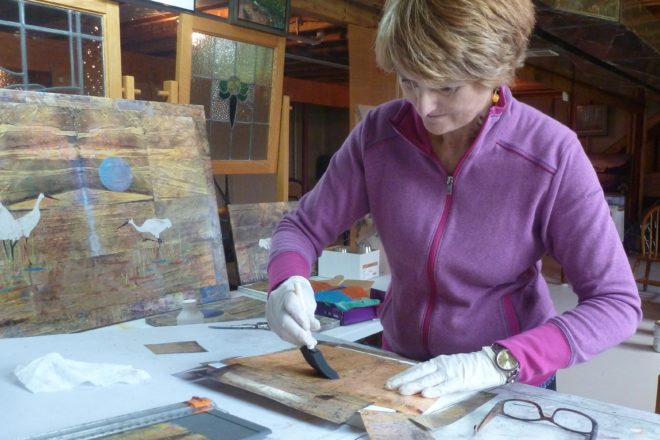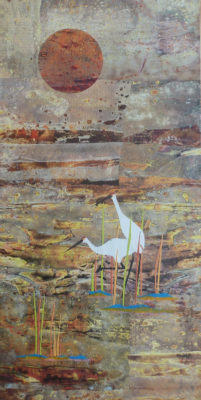Artist Gail McCoy Found Her Voice through Cranes and Collage
- Share
- Tweet
- Pin
- Share

When Gail McCoy retired from 29 years of teaching elementary students, her husband bought her a beautiful new easel. He knew she always wanted to be an artist, “but that’s not a logical thing when you’re supporting a family,” she said.
For nearly a year, the easel sat empty. “I couldn’t get anything to work from my brain to the paper,” said McCoy. She tried watercolors of landscapes and flowers. “I wanted to do something innovative and unique, but everybody was doing those,” she said. “I didn’t have anything that was my voice.”
Then a friend invited her to take an art class with her: Experimental Watercolor with Maryann Inman. “There were no rules. It was just the right thing for me,” said McCoy. “You can’t do anything wrong.”
Inman instructed her students to tear up scraps of paper – tissue paper, crepe paper – lay them on canvas and haphazardly pour paint over them. “After 24 hours, when you pulled off the paper, it created these impressions. I loved the process. I kept going to this gal’s classes, after a year and a half she said, ‘You have a real gift.’”
The gift requires some fairly labor-intensive work with some very specific materials – issues of National Geographic before 2011 and oranges.
“The magazine uses high quality gloss, the best in the business,” McCoy said, that is – before they changed their printing process in 2011. “I’m always looking for NatGeos published before then,” she said, laughing.
She rips pages out of the magazine and paints on a natural citrus solvent. “That liquid causes the ink to move, making luscious colors and patterns, totally abstracts the photo in the magazine.”
She sets aside half a day for making the paper. “It’s a very depleting activity. It needs to be very hot; the hotter the better,” she explained. “So, it’s not pleasant.”
But pleasant enough to keep her intrigued. “I really enjoy making the art, the physical reaction to the paper, the process. But it isn’t complete until in connects with someone else.”
Her early works were abstract. Just to see what might happen, if any connection were made, she decided to show them in an art show. “They all sold,” she said. “A psychiatrist bought five! That told me, I’m not the only one who likes these.”
After creating abstracts, she moved on to creating imaginary birds, framed and matted. “They were selling, but the framing and matting upped the pricing. I was limiting my demographic base.” Five years ago, on a New Year’s morning, she woke up with a new subject in mind: “Gallery wrapped pieces and small white cranes.”

“A Lively Conversation” by Gail McCoy
Since a difficult time years ago, cranes have been a symbol of hope and gratitude for McCoy. “I do them because back when I was going through a tough time, that summer, three sandhills would go outside my kitchen window at 8:30 am every morning. It told me to keep going, things will get better. And they did. I’m so grateful for where I am in life.”
Cranes also act as universal iconic symbols of health, happiness, healing, freedom and longevity. Cranes speak to many individuals in a variety of ways.
“It seems when someone buys a piece, it’s almost an immediate connection, very powerful,” said McCoy. “They often tell me a story about how the piece affects them – they may have lost a husband or a child or are going through a divorce. I had a retired couple who said the piece reminded them of their home in Nebraska, they hung it in their new home in Idaho and it tied their whole history together. It’s a really impactful position to be in – the art means something to people.”
Her art is hanging in homes, offices, apartment complexes, and art shows throughout the country. This winter, she participated in 10 shows while staying in Florida. “I literally sold out of my art supply,” she said. “I have to rebuild my inventory.”
McCoy’s husband, Ken, helps her during these various shows she participates in throughout the country. “He’s an engineer, with a good eye for art. At the tent sales, he takes care of the money and I talk with the people. He will rehang a piece after something sells.”
It was during an art show in Sturgeon Bay that McCoy met potter and gallery owner Chad Luberger of Plum Bottom Pottery & Gallery. “This couple comes in and after a while a gentleman says, ‘I’d like you to be represented in my gallery.’” McCoy politely declined. “I’m not doing galleries right now,” she said. A half-hour later the man reappeared, “I don’t think you understand. I want your work in my gallery.” The gentleman was Luberger, who showed her around his gallery that evening.
“We liked what we saw and ended up leaving 16 pieces – they sold in a month,” she said. “That was the start. They are the best people to work with. They give good feedback, help me with pricing, promote me. I’m very appreciative.”
McCoy is also appreciative to have found an expression that’s just hers. “When I started there was no guarantee that something would hit me. I thought, ‘I’m just gonna take what comes my way. I’m just gonna stay open to the universe.’ And now I feel like I’m home. It’s my voice, my expression. I don’t feel like I’m stepping on anyone’s toes or style.”
And when someone finds a piece, she loves to see it bring that “joy, satisfaction, completion, connection.”
McCoy’s art sales help support the International Crane Foundation in Baraboo, the Audubon Society and Navajo Water Project.
Plum Bottom Gallery, located at 4999 Plum Bottom Road near Egg Harbor, will host an artist reception for Art Show 5, featuring McCoy, on June 9, 10 am – 5 pm. McCoy will be on hand to answer questions about her work 11 am – 1 pm. For more information about McCoy visit gailmccoyart.com or plumbottompottery.com.



